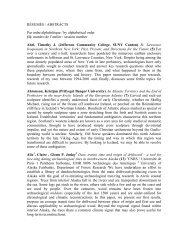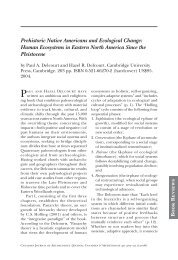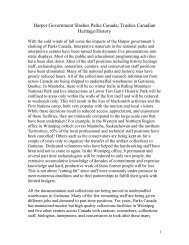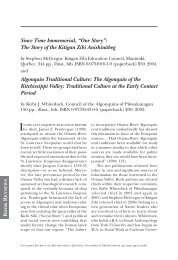16 - 20 MAI MAY 16 - 20 - Canadian Archaeological Association
16 - 20 MAI MAY 16 - 20 - Canadian Archaeological Association
16 - 20 MAI MAY 16 - 20 - Canadian Archaeological Association
You also want an ePaper? Increase the reach of your titles
YUMPU automatically turns print PDFs into web optimized ePapers that Google loves.
produits associés à la pharmacopée traditionnelle des populations<br />
autochtones, suggérant une continuité dans l’utilisation des produits<br />
de la médecine traditionnelle depuis la préhistoire.<br />
Bevan, Andrew (Institute of Archaeology, University College London)<br />
• Modelling the interaction of paths and places in prehistoric environments<br />
[26]<br />
Geographers have a long tradition of modelling settlement hierarchies,<br />
as well as a continuing interest in routing problems both<br />
through discrete networks such as road systems, and across continuous<br />
landscapes. Archaeologists have an interest in understanding<br />
how settlements, camps and other more enduring areas of human<br />
activity distribute themselves across a landscape, how such places interact<br />
with one another, how travel between them is structured, and<br />
what role the environment plays as a forcing factor. Unfortunately, the<br />
paleoenvironmetal evidence available to archaeologists is often far<br />
more patchy than for those studying the present day or very recent<br />
periods of human history. This paper will address these challenges,<br />
emphasising the increasing relevance of methods such as point process<br />
models, spatial interaction models, moderate levels of environmental<br />
realism and Monte Carlo simulation.<br />
Bilton, David, and Gay Frederick • What Does Northern Gulf Diversified<br />
Fishing Look Like? Presenting Archaeofaunal Data from Shishalh<br />
Territory, British Columbia [14]<br />
Different fishing adaptations were noted amongst Coast Salish groups<br />
in the Gulf of Georgia. Northern groups had a diversified fishing adaptation,<br />
while Central and Straits groups had more specialized fishing<br />
technologies. <strong>Archaeological</strong> investigations have traditionally focused<br />
in the latter areas, and these data have been well-used to understand<br />
the development of ethnographic cultural traits. This paper presents<br />
new archaeofaunal data from the traditional territory of the Shishalh<br />
nation, the southernmost Northern group, to expand our understanding<br />
of prehistoric cultural diversity amongst the Coast Salish.<br />
Birch, Jennifer (University of Georgia) • Between Villages and Cities:<br />
Settlement Aggregation and Community Transformation [3]<br />
Archaeologists have focused a great deal of attention on explaining<br />
the origins of village societies and the transition to a Neolithic way<br />
of life. Considerable interest has also concentrated on urbanism and<br />
the rise of the earliest cities. Between these two revolutions in human<br />
cultural development lies a critical and under-theorized phase in societal<br />
evolution. Throughout world, at various points in time, people<br />
living in small, dispersed village communities have come together<br />
into larger and more complex social formations. This paper will begin<br />
with an exploration of the social processes involved in the creation<br />
and maintenance of aggregated settlements and how they brought<br />
about transformations that affected virtually every aspect of a society<br />
and its culture. It will conclude with a discussion of how the archaeological<br />
record of Northern Iroquoian communities is particularly well<br />
suited to understanding how changes in community-based practices<br />
relate to cultural change at the regional scale.<br />
Blair, Susan E. (University of New Brunswick), Matthew K. Litvak<br />
(Mount Allison University) and W. Jesse Webb (University of New<br />
Brunswick) • The Precontact Sturgeon Fishery of the Miramichi River<br />
Drainage, Northeastern New Brunswick, Canada [14]<br />
The modern community of Metepenagiag Mi’kmaq Nation is located<br />
in northwestern New Brunswick, Canada, at the confluence of the<br />
Northwest and Little Southwest Miramichi Rivers, near the modern<br />
head-of-tide. This area has a high density of recorded precontact archaeological<br />
sites, including two National Historic Sites, the Oxbow<br />
Site, and the Augustine Mound. When combined with local knowledge<br />
and historical information, these sites contain rich, contextualized<br />
information about the period between 3500 and 500 years ago, and<br />
are the focus of long-term collaborative research between archaeologists,<br />
biologists, community researchers and institutions, such as Metepenagiag<br />
Heritage Park. On most of these sites, calcined sturgeon<br />
scutes and spines (many identified as Acipenser oxyrinchus) dominate<br />
faunal assemblages. This paper will explore the distribution of<br />
sturgeon remains in these sites, and present preliminary NSERCsupported<br />
research on their implication for our understanding of the<br />
relationship among the ancient Mi’kmaq of Metepenagiag, the Miramichi<br />
River, and sturgeon.<br />
Blouin, Yanik (Consultant) • Travaux archéologiques au Champ-de-<br />
Mars : analyse et comparaison des modes de construction chez deux<br />
équipes de maçons du XVIII e siècle [27]<br />
En 1717, Chaussegros de Léry amorce la construction d’une enceinte<br />
bastionnée protégeant la ville de Montréal. Le projet n’est achevé<br />
qu’en 1744 et il aura requis la participation de plus de 230 artisans et<br />
journaliers, sans compter l’aide apportée par les soldats en poste dans<br />
la ville. Aujourd’hui, les vestiges mis en valeur au Champ-de-Mars<br />
constituent l’unique exemple d’un front complet de cette ancienne<br />
fortification. Les travaux de restauration qui ont pris place en <strong>20</strong>10<br />
ont donné l’occasion de procéder à un relevé exhaustif des parements<br />
de l’escape et de la contrescarpe. Leur analyse permet de reconstituer<br />
les gestes de deux équipes différentes de maçons, de même qu’elle<br />
soulève de nouvelles avenues pour l’enregistrement et la description<br />
des vestiges archéologiques.<br />
Under Chaussegros de Léry, Montreal’s fortification was built between<br />
1717 and 1744. Today, Champ-de-Mars remains are the last<br />
example of a complete front of this old fortification. In <strong>20</strong>10, an archaeological<br />
survey allows an exhaustive drawing of the walls. Their<br />
analysis shows differences between two mason teams. Also, the conclusion<br />
brings some new ways in field archaeology.<br />
Bonneau Adelphine (Université du Québec à Chicoutimi), Jean-<br />
François Moreau (Université du Québec à Chicoutimi), Réginald<br />
Auger (Université Laval), et Bertrand Emard (Hydro-Québec) •<br />
Analytical studies of European Trade Glass Beads in Quebec: what instrument<br />
for what kind of results? [21]<br />
Chemical analysis on trade glass beads in Quebec were performed<br />
since the 1990’s by Ron Hancock and Jean-François Moreau using<br />
Neutron Activation Analysis (NAA) (Hancock et al. 1996, Moreau et<br />
Hancock <strong>20</strong>10). This work results on a huge database of trade glass<br />
beads composition that can provide an estimate dating for the beads<br />
by comparison of the chemical composition. However, new questions<br />
are asked by the archaeologists: how were these beads made? Is it<br />
possible to make sub-groups in the dating groups in order to follow<br />
the penetration of beads from their coastal point of arrival into the<br />
continent? In literature, two techniques are more and more developed:<br />
Raman spectroscopy, which gave us the opportunity to find the<br />
“shape” of the opacifiers in the glass, to identify the type of glass and<br />
to make different groups of beads because of their glass type; and LA-<br />
ICP-MS, gave us the total composition of the glass with the analysis of<br />
38 chemical elements and thus makes possible to defined sub-groups<br />
of beads which correspond with archaeological evidence on the site.<br />
Bouchard-Perron, Julie-Anne, Émilie Young-Vigneault et Nadia<br />
Ardila (G.A.I.A. Inc.) • Se doter d’un toit et d’une pitance au 17 e siècle:<br />
Résultats des analyses environnementales sur le site du Parc des Braves<br />
à Québec [30]<br />
Au cours de la fouille du site du Parc des Braves par la Commission<br />
des Champs de Bataille Nationaux à l’été <strong>20</strong>11, deux logis érigés au<br />
17 e siècle et visiblement incendiés avant le 18 e siècle ont été mis au<br />
jour. L’analyse des échantillons de sol et de bois prélevés dans ces<br />
logis par l’équipe de GAIA Inc. a permis d’acquérir plusieurs informations<br />
autrement inaccessibles et concernant la façon dont les logis<br />
ont été construits, divisés, utilisés et détruits. Les résultats obtenus<br />
jettent une lumière nouvelle sur le processus de colonisation aux<br />
environs de Québec et sur la manière dont les colons ont pu combiner<br />
des techniques anciennes et un environnement nouveau pour<br />
se créer un mode de vie unique.<br />
Bouchard-Perron, Julie-Anne, Jacynthe Bernard et Nadia Ardila<br />
(G.A.I.A. Inc.) • Vendre, acheter et échanger à Montréal au 19 e<br />
siècle : Résultats des analyses environnementales sur le site de la Place<br />
d’Youville [27]<br />
Situé en plein cœur du vieux-Montréal, le site de la Place d’Youville<br />
a abrité successivement deux édifices imposants ayant été utilisés<br />
comme marchés au 19 e siècle. L’étude des restes botaniques, entomologiques<br />
et fauniques provenant de dépôts associés aux marchés<br />
et excavés par la firme Ethnoscop Inc. a permis d’obtenir une perspective<br />
unique quant à la façon dont les activités mercantiles se déroulaient<br />
à l’intérieur des édifices. De la salubrité des lieux aux produits<br />
échangés en passant par les techniques de boucherie employées et la<br />
répartition des activités en allant jusqu’aux réseaux d’échanges déployés<br />
et à la façon dont les tendances observées s’inscrivent dans le<br />
monde occidental, cette présentation proposée par GAIA Inc offre un<br />
survol de l’expérience de «faire son marché» au 19 e siècle.<br />
28








